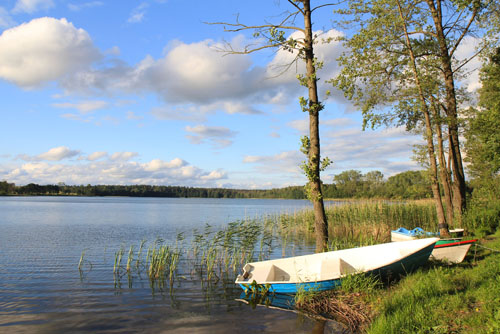 Arboretum in Wirty – 2 km. Founded in 1875, it is one of the largest arboreta in Europe. If features 145 coniferous and 310 deciduous tree species.
Arboretum in Wirty – 2 km. Founded in 1875, it is one of the largest arboreta in Europe. If features 145 coniferous and 310 deciduous tree species.- Madieval fortified settlement in Owidz – 15 km. A reconstruction of an early medieval settlement with an area of 45,000 square meters. It features exhibitions, a harbour, an archery range and a playground.
- Pelplin Basilica – 24 km. Built in the Gothic style, it originally belonged to a Cistercian monastery. It is the largest Brick Gothic church in Poland. It features a monumental altar, a number of side-altars, choirs, a pulpit and a pipe organ.
- Open-air museum in Wdzysze Kiszewskie – 42 km. Located on Lake Gołuń, it occupies an area of 22 hectares. The museum was founded in the early 20th century. It features peasant cottages, manors, a school, blacksmith’s, inns, mills, churches, farm buildings and craftsman’s workshops.
- Gniew Castle – 42 km. The best preserved castle of the Teutonic Order in Pomerania, located on the high embankment of Vistula River, next to the town square.
- Malbork Castle – 49 km. The former seat of the grandmasters of the Teutonic Order and the largest Gothic castle in Europe. This elaborate complex of buildings includes the low, medium and high castle, and covers 20 hectares. In the Middle Ages, it used to be the capital of the Teutonic state.
- Fojutowo aqueduct – 49 km. A unique treasure of hydrological engineering inspired by ancient Roman constructions. Tourist attractions nearby include: swimming pools, a ski lift, playground for children, hotel, restaurant, canoe trips, tennis courts, a skating rink and sports pitches.
- Stone circles at Odry – 49 km. Odry is one of the most famous and best preserved site of stone circles, and one of the most valuable cultural sites of its kind in Europe. The Odry Stone Circles Reserve have a permanent archeological and natural exhibition that attracts many tourists year after year. The exhibition features two parts: the first one presents the most valuable archeological finds that documents the material and spiritual culture of the Goths. The natural part presents a number of extremely valuable lichens found in the reserve and in the Tuchola Forest.
- Open-air museum in Szymbark – 59 km. Szymbark boasts some of the most unique exhibits in Europe and possibly the World. These include the World’s Longest Plank and the World’s Biggest Pianio, the Upside-Down House, the Siberian House with a labour camp, the Gryf Pomorski Memorial and Bunker, the Scout’s House, the Museum of Carpentry, Salino Manor, and many others.
- Gdańsk – 63 km. With its impressive Gothic, Renaissance and Baroque architecture, Gdańsk has more than enough attractions to offer. The most important landmarks of the city are located in the Main and Old City and include the Royal Route, Długa Street, the Long Market, the Golden Gate and the Green Fate, and Mariacka Street, where amber artisans and other artists will invite you to their shops and galleries.
- Sopot – 80 km. One of the most enchanting Polish cities and one of the most scenic seaside resorts of the Baltic coast. It is just is charming every time of day and night and every season of the year.
